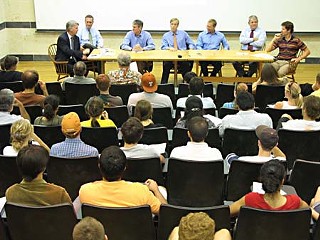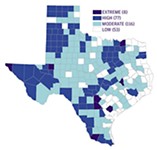UT Students Ignite Streetcar Passions
A UT forum on light rail got heavy last week
By Katherine Gregor, Fri., Sept. 19, 2008

Rail 4 Real, a University of Texas student group advocating for rail transit to serve the UT campus, held its kickoff event Sept. 10. An audience of about 100 students, faculty, and others heard an overview of the Austin streetcar system recommended by the city's ROMA consultant team, followed by a panel discussion and Q&A session.
"It's refreshing to see a fresh group of faces" excited about transit issues, noted panel moderator John Langmore. Allied student groups organizing the event included UT's Urban Development Society, the Campus Environmental Center, and student government. Generating strong interest was the discussion over whether the campus streetcar alignment should run along San Jacinto, as desired by UT's administration; on the more central Speedway; or on Guadalupe.
Dramatizing the passions sometimes ignited by transit and sustainability issues was an alleged assault by Skip Cameron, who sits on the Coalition on Sustainable Transportation executive committee with Jim Skaggs and Travis Co. Commissioner Gerald Daugherty. Already agitated, Cameron was asked by UT student Greg Anderson, who had helped organize the event, to desist from distributing outside materials (promoting a different transportation approach), in accordance with university policy. When Cameron refused, Anderson asked him repeatedly to leave. According to eyewitnesses, Cameron grabbed the student around the throat and pushed him against a limestone wall, desisting when transit advocate Glenn Gadbois and others intervened. University Police subsequently took Cameron into custody, but Anderson chose not to press charges. According to the incident report, police issued Cameron a criminal trespass warning. Cameron says he had simply been defending himself after Anderson grabbed his arm and tried to take his handouts.
Capital Metro Executive Vice President Doug Allen presented ROMA's recommendations for a rail system; the transit authority is developing a detailed follow-up proposal. Panel participants included Austin Mayor Pro Tem Brewster McCracken; Texas state Rep. Mike Krusee; Fritz Steiner, UT dean of architecture; Bob Harkins, UT associate vice president for campus safety and security; and Austin Chamber of Commerce representative Brandon Janes. McCracken, Krusee, Steiner, and Janes sit on the Transit Working Group, which is expected to review Cap Metro's proposal to the Capital Area Metropolitan Planning Organization in November; an authorizing voter referendum also would be required, possibly next May. When Langmore asked, "Who would vote to expand our rail system today?" nearly everyone in the student-packed room raised a hand. But the rail-friendly Janes warned, "We need to be realistic about the ability to sell this very substantial investment to the community in general." As he characterized the attitude of some voters: "I don't want to pay $600 million to haul around a bunch of yuppies."
Noting that the rail line would be electricity-powered, McCracken (who also serves on Cap Metro's board) referenced the leap in the agency's diesel-fuel bill, between the 2007 and 2008 budgets, from $11 million to $25 million. He also stated that Houston now has 50,000 rail riders a day – the No. 2 ridership in the U.S.
Harkins said Cap Metro shuttle buses serving the campus already carry 7 million passengers annually. "We want rail to link places where students live to the campus," he said, referencing Riverside Drive, West Campus, and Cameron Road. But UT representatives have said previously that UT will not be a financial partner in the streetcar project unless it gets service to its Pickle campus in North Austin, targeted for future development. "It's got to be viewed as a regional rail system," Harkins emphasized.
Objected Krusee, "UT said, 'We don't want to pay one dime!'" Enjoying the freedoms of an official not running for re-election, he continued irreverently, "'And we don't want to talk about where it's going to go, because it's going to go on San Jacinto! For reasons we don't want to talk about!'" Criticizing UT, he also called the nearby stretch of Waller Creek through campus "a stinkin' pit!"
"What I'd really like to have is a circulator that goes all the way around campus," Harkins allowed, after reasserting UT's choice of San Jacinto. "A loop that goes down Guadalupe would be great." Dean Steiner agreed: "The ideal solution in my view is a loop." Steiner encouraged the audience to study the "beautiful" campus master plan, which shows a pedestrian mall now estimated at $110 million for Speedway and designates San Jacinto for future rail service. "One hundred ten million dollars so people can have a better sidewalk?" Krusee jibed. "Why don't we have an open debate? Why don't we appoint a panel to really look at this thing?" His comments were greeted by audience applause.
Two more Rail 4 Real events are upcoming. On Thursday, Sept. 25, at 7pm, the Campus Environmental Center will host UT professor Sinclair Black, who has led the argument that a rail line should be located closer to current activity nodes. On Wednesday, Oct. 15, at 7pm, the Rail 4 Real coalition will host a related discussion between Austin Mayor Will Wynn and UT President William Powers. For more information, visit www.rail4real.org.
Got something to say on the subject? Send a letter to the editor.










